List of slums
This article needs additional citations for verification. (December 2015) |
This article may contain unverified or indiscriminate information in embedded lists. (December 2015) |
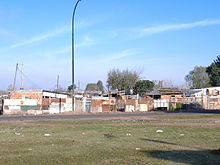

This is a list of slums. A slum as defined by the United Nations agency UN-Habitat, is a run-down area of a city characterized by substandard housing, squalor, and lacking in tenure security. According to the United Nations, the percentage of urban dwellers living in slums decreased from 47 percent to 37 percent in the developing world between 1990 and 2005.[1] However, due to rising population, and the rise especially in urban populations, the number of slum dwellers is rising. One billion people worldwide live in slums[2] and the figure is projected to grow to 2 billion by 2030.[3]
Africa
Egypt
- Ezbet el-Haggana – a slum in Cairo
- Manshiyat Naser – slum in Cairo
Ghana

- Amui Djor[4]
- Ashiaman[5]
- Fadama[6]
- Jamestown/Usshertown, Accra
- Kojokrom
- New Takoradi
- Suame Magazine
- Nima
- Agbogbloshie
Kenya

- Baba Ndogo
- Dandora
- Fuata Nyayo[7]
- Gatwekera
- Huruma
- Kambi Muru
- Kangemi
- Kawangware
- Kiambiu
- Kianda
- Kibera (Kibera has been described as the largest slum in Kenya)
- Kiamaiko
- Kichinjio
- Kisumu Ndogo
- Korogocho
- Laini Saba
- Lindi
- Majengo, Nairobi
- juakali-marurui, Nairobi
- Makongeni
- Mashimoni
- Matopeni
- Mathare
- Mathare Valley
- Mugumoini
- Mukuru kwa Njenga
- Mukuru slums
- Nyalenda
- Pumwani
- Raila
- Sarang'ombe
- Shilanga
- Siranga
- Soweto East
- Soweto West
- Ziwa la Ng'ombe[8]
- Viwandani (Kenya)[9]
Liberia
- Brewerville
- Clara Town, Bushrod Island
- Logan Town
- Sinkor
- Slipway
- Sonewein
- South Beach Bay
- West Point
Mauritania
Namibia
- Africa Tongashili
- Freedomland
- Goreangab
- Okahandja Park
- Okandundu
- Okantunda
- Okuryangava
- One Nation N° 1
- One Nation N° 2
- Ongulumbashe N° 1
- Onyika
- Otjomuise
- Samuel Maherero
Nigeria
- Agege
- Ajegunle
- Amukoko[10]
- Badia
- Bariga
- Bodija
- Ijeshatedo/Itire
- Ilaje
- Iwaya[11]
- Makoko[11]
- Mushin[12]
- Oke-Offa Babasale
- Somolu
- Idikan
- Sasa
South Africa
- Alexandra[13]
- Cato Manor
- Chatsworth
- Fisantekraal
- Freedom Park
- Gamalakhe
- Gugulethu
- Ibhayi
- Inanda
- Joe Slovo Park
- Kennedy Road
- Khayelitsha
- KwaDabeka
- KwaMakhutha
- KwaMashu
- KwaNobuhle
- Langa
- Lwandle
- Mdantsane
- Mitchells Plain
- Motherwell
- Nomzamo
- Ntuzuma
- Nyanga
- Philippi
- Thembalethu
- Wallacedene
Spain
Asia
Bangladesh
- Begun Bari[14]
- Bhola (Dhaka North)
- City Palli (Dhaka South)
- Driver Colony (Dhaka South)
- Duaripara (Dhaka North)
- Kawnia
- Korail slum (Dhaka North)
- Lalbagh (Slum)|Lalbagh
- Mach Colony
- Mannan (Dhaka South)
- Mohammadpur (Slum)|Mohammadpur
- Molla (Dhaka North)
- Monsur Beel / Nama Para
- Mymensingh (Slum)|Mymensingh
- Nubur (Dhaka South)
- Power House (Dhaka South)
- Pura (Dhaka South)
- Rail Line Slums (most of the largest rail lines in Bangladesh have slums)
Hong Kong
- Kowloon Walled City (demolished)
India
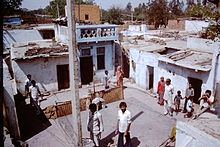
- Kirti Nagar, Delhi, Delhi
- Munirka, Delhi, Delhi
- Kathputhli Colony, Delhi
- Talkatora, Delhi
- Pilkhana, Kolkata
- Tikiapara, Kolkata
- Basanti, Kolkata
- Chandmari, Guwahati
- Dharavi, Mumbai
- Banganga, Mumbai
- Baiganwadi, Mumbai
- Antop Hill, Mumbai
- Vyasarpadi, Chennai
- Royapuram, Chennai
- Thiruvotriyur, Chennai
- Salia Sahi, Bhubaneswar[15]
Indonesia
- Kampung Dao and Kampung Muka, near Jakarta Kota railway station
- Kampung Kalibaru, a 1.6 km2 slum near New Priok Container consisting of substandard housing with bad sanitation and bad waste management, junk warehouse, metal scrapping field, and fishing boat manufacturer which directly faces Jakarta Bay
- Kampung Tanah Merah Plumpang, where 2023 Plumpang oil depot fire tragedy happened which took about 33 lives of people
- Kampung Muara Baru, along East towards North side of Pluit Reservoir
- Kampung Kalimati, West side of Karet Bivak Cemetery
- Jalan Bhakti and Jalan Remaja towards Jl. Bukit Duri Utara, officially owned by Kereta Api Indonesia but squatted in the early 70's until now
- Tanah Rendah, Kebon Pala, Bukit Duri and surrounding area in Matraman and Manggarai along Ciliwung River
- Kampung Bahari, Kampung Kebon Pisang towards Tanjung Priuk railway station
- Gang Royal, a suspected illegal prostitution area near Harbour Toll Road
- Rawa Malang, a suspected illegal prostitution area near Budi Dharma Cemetery along Cakung River Drainage
- Slums near railway stations and rail lines (worst in Jakarta, Semarang and Surabaya)
- Every unfenced or unguarded lands in metropolitan area or urban area exists some squatters
- Riverbanks, landfills, public parks, old Chinese Cemetery, government lands, or lakeside often seen squatters working as scavengers and scrap collectors
Iran
As of 2022-23 twenty to twenty five million Iranians lived in slums.[16][17]
Japan
Pakistan
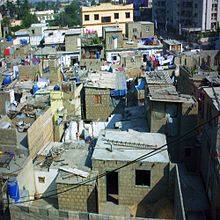
- Parts of Machar Colony[25]
Previous Slums in Pakistan
- Orangi, previously but status changed to municipality from 2018 onward.
South Korea
Sri Lanka
- Usavi Watta (Usaui Walta)
- Wanathamulla
Thailand
Turkey
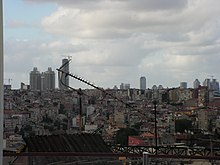
- Sultanbeyli, Istanbul
- Çinçin, one of the most popular Turkish gecekondu (slum) located in Ankara
- Hacıhüsrev, largest slum of İstanbul
- Hürriyet mahallesi, Adana
- Kadifekale, Izmir
- Horozköy, Manisa
Yemen
Oceania
Australia
- Little Lon district – In the nineteenth century the area consisted of timber and brick cottages, shops and small factories and was home to an ethnically diverse and generally poor population. Today there are few reminders of the area's former notoriety.
Europe (formerly)
The following are former slum areas that have subsequently been either gradually developed or abruptly cleared and demolished.
Bulgaria
- Fakulteta, Sofia
- Filipovtsi, Sofia
- Hristo Botev, Sofia
- Stolipinovo, Plovdiv
- Sheker Mahala, Plovdiv
- Hadji Hasan Mahala, Plovdiv
- Arman Mahala, Plovdiv
- Maksuda, Varna
Greece
Agia Kyriaki, Acharnes, Athens
Nea zoi, Aspropyrgos, Attica
Italy
- Fondo Fucile in Messina[26]
- Maregrosso in Messina
- Rione Taormina in Messina
- Santa Lucia sopra Contesse in Messina
- Giostra in Messina
- Ciambra in Gioia Tauro
- Arghillà in Reggio Calabria
- Ciampa di Cavallo in Lamezia Terme
- Germaneto in Catanzaro
- Acquabona in Crotone
- Via degli Stadi in Cosenza
- Timpone Rosso in Cassano allo Ionio
- Scampia in Naples
- Ponticelli in Naples
Malta

- The Manderaggio, an area in Valletta that was a slum area from the 16th to 20th centuries. It was demolished in the 1950s and replaced by housing estates.
Spain
Portugal
- Cova da Moura, Amadora, Lisbon
- Fontainhas, Amadora, Lisbon
- Venda Nova, Amadora, Lisbon
- Barruncho, Lisbon
- Bairro da Jamaica, Amora, Seixal
Serbia

- Cardboard city (Template:Lang-sr) in Belgrade, depopulated and demolished starting on 31 August 2009, following four years of unsuccessful attempts.
North America



Bahamas
- Over The Hill it is the largest and most populous of the Bahamas with about 2.5 km²
Haiti
Jamaica
Mexico
- Neza-Chalco-Ixta in Mexico City, is a Ciudad Perdida, rated as the world's largest mega-slum in 2006. The area extends towards the municipalities of Chimalhuacan, Los Reyes to the west of Ixtapaluca and South of Neza and Ecatepec de Morelos north of Neza in the metropolitan area periphery and with Santa Marta Acatitla in the Distrito Federal's borough of Iztapalapa.
Puerto Rico
South America
Argentina

In Buenos Aires:
Brazil
Shanty towns in Brazil are referred to as favelas.

- Cidade de Deus
- Complexo do Alemão
- Santa Marta
- Jacarezinho
- Mangueira
- Manguinhos
- Morro da Babilônia
- Rocinha
- Serrinha
- Vidigal
- Vigário Geral
- Heliópolis
- Paraisópolis
- Ilha das Cobras
Colombia
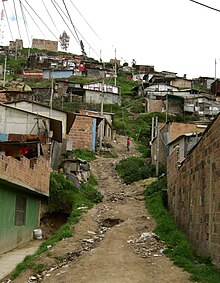
Paraguay
Peru
Pueblos jóvenes is the nickname given to the vast shanty towns that surround Lima and other cities of Peru. Many of these towns have developed into significant districts in Lima such as Villa El Salvador and Comas District, Lima.
- Comas
- Villa El Salvador
- San Juan de Lurigancho
- Cono Sur
Uruguay
Venezuela
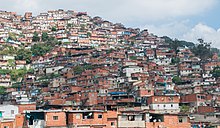
See also

- Campamento (Chile) – a term in Chile to shanty towns.
- Chengzhongcun – less prosperous areas in urban areas in China.
- Cortiço – a Portuguese term commonly used in Brazil and Portugal to describe an area of urban housing where many people live in conditions of poor hygiene and poverty.
- Rugby boy – a common group or gang of street children seen in the Philippines, they are one of the most well known and recognized poverty inflicted people found in the slums of the Philippines.
- Slum upgrading – consists of physical, social, economic, organizational and environmental improvements to slums undertaken cooperatively and locally among citizens, community groups, businesses and local authorities.[27]
- Villa miseria – a type of shanty town or slum found in Argentina
 Geography portal
Geography portal Lists portal
Lists portal
References
- ^ United Nations, 2007. The Millennium Development Goals Report. Archived 2017-07-13 at the Wayback Machine p. 26
- ^ "Review of Mike Davis' 'Planet of Slums'". The Struggle for the City. Archived from the original on 5 October 2011. Retrieved 30 April 2016.
- ^ Slum Dwellers to double by 2030 Archived 2013-03-17 at the Wayback Machine UN-HABITAT report, April 2007.
- ^ Zimring, Carl A.; Rathje, William L. (29 February 2012). Encyclopedia of Consumption and Waste. ISBN 9781412988193. Archived from the original on 16 February 2022. Retrieved 30 April 2016.
- ^ "The Challenge of Slums". 2003. Retrieved 30 April 2016.
- ^ Grant, Richard (28 February 2009). Globalizing City. ISBN 9780815631729. Retrieved 30 April 2016.
- ^ "Kenya National Assembly Official Record (Hansard)". 28 October 2010. Retrieved 30 April 2016.
- ^ Syrjanen, Raakel (2008). UN-Habitat and the Kenya slum upgrading programme. ISBN 9789211319903. Retrieved 30 April 2016.
- ^ "Mapping for better healthcare in Nairobi's slums". CIMSpatial group at the Centre of Interdisciplinary Methodologies (CIM), University of Warwick, UK. Archived from the original on 10 July 2018. Retrieved 10 July 2018.
- ^ Mason, Paul (2010). Live Working Or Die Fighting. ISBN 9781608460700. Retrieved 30 April 2016.
- ^ a b Dodman, David; Bicknell, Jane; Satterthwaite, David (31 May 2012). Adapting Cities to Climate Change. ISBN 9781136572531. Retrieved 30 April 2016.
- ^ Global Politics in a Changing World. 2009. ISBN 9780618974511. Retrieved 30 April 2016.
- ^ Kok, Pieter (1998). South Africa's Magnifying Glass. ISBN 9780796918796. Retrieved 30 April 2016.
- ^ Ramesh, Randeep (22 December 2006). "Hidden cost of 'cheap chic'". The Guardian. London. Archived from the original on 2016-03-06. Retrieved 2008-11-24.
- ^ http://bmc.gov.in/Download/BMC%20Slums.pdf Archived 2019-03-03 at the Wayback Machine [bare URL PDF]
- ^ "25-%D9%85%DB%8C%D9%84%DB%8C%D9%88%D9%86-%D9%86%D9%81%D8%B1-%D8%A7%D8%B2-%D8%AC%D9%85%D8%B9%DB%8C%D8%AA-%D8%A7%DB%8C%D8%B1%D8%A7%D9%86-%D8%AD%D8%A7%D8%B4%DB%8C%D9%87-%D9%86%D8%B4%DB%8C%D9%86-%D8%A7%D9%86%D8%AF-%D8%AF%DA%86%D8%A7%D8%B1-%D8%B9%D9%82%D8%A8-%D8%A7%D9%81%D8%AA%D8%A7%D8%AF%DA%AF%DB%8C". www.isna.ir. Retrieved 2023-06-12.
- ^ "جامعهشناس ایرانی: 20 میلیون حاشیهنشین داریم". www.aa.com.tr. Retrieved 2023-06-12.
- ^ "درصد جمعیت اصفهان ، حاشیه نشین هستند". www.irna.ir. Retrieved 2023-05-19.
- ^ "شناسایی 9 منطقه حاشیهنشین در اصفهان » اصفهان امروز آنلاین". اصفهان امروز آنلاین (in Persian). Archived from the original on 2020-02-24. Retrieved 2023-05-19.
- ^ "دارک؛ حاشیهای ناامن و رهاشده در اصفهان » اصفهان امروز آنلاین". اصفهان امروز آنلاین (in Persian). Archived from the original on 2020-02-05. Retrieved 2023-05-19.
- ^ "سکونت 19 میلیون و 700 هزار ایرانی در محلات فرسوده یا حاشیهنشین- اخبار اصفهان - اخبار استانها تسنیم | Tasnim". خبرگزاری تسنیم | Tasnim (in Persian). Archived from the original on 2023-05-18. Retrieved 2023-05-19.
- ^ ربانی, رسول; وارثی, حمیدرضا; طاهری, زهرا (2009-03-24). "تحلیلی بر علل اصلی شکل گیری مناطق حاشیه نشین در شهر اصفهان نمونه ی موردی منطقه ی ارزنان و دارک". جغرافیا و توسعه (in Persian). 13 (7): 93–126.
- ^ a b رسول, ربانی خوراسگانی; صمد, کلانتری; نفسیه, یاوری (2004-01-01). "پدیده حاشیه نشینی و پیامدهای اجتماعی، فرهنگی آن (ارزنان و دارک اصفهان)" (in Persian). 17 (2): 119–154.
{{cite journal}}: Cite journal requires|journal=(help) - ^ "خانههای دودی پدیده نوظهور در تهران | خبرگزاری صدا و سیما". 2023-06-11. Archived from the original on 2023-06-11. Retrieved 2023-06-11.
- ^ "Demolishing Slums". The Nation. 2015-07-12. Archived from the original on 2019-02-10. Retrieved 2018-07-10.
- ^ demolished/undergoing demolition
- ^ [1] Archived 2013-05-28 at the Wayback Machine "What Is Urban Upgrading?" MIT. Accessed 3 December 2010
External links
![]() Media related to Slums at Wikimedia Commons
Media related to Slums at Wikimedia Commons
